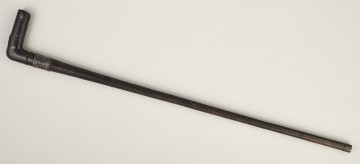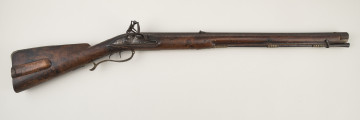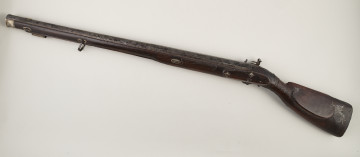
Shooting stick
20th century
Castle Museum in Łańcut
Part of the collection: Weapons, music instruments, varia
Rifle with Percussion Lock The invention of gunpowder on battlefields resulted in another “arms race.” Work on new types of long arms, hand guns and artillery weapons started. The inventors changed calibres, searching for the most adequate to neutralise armour-clad opponents, as well as the weight of weapons in order to allow for horseback shooting. To improve accuracy, more and more precise sights started to be applied, along with rifled barrels. An important element that guaranteed effective shots, irrespective of the weather conditions and individual training, was the reliable lock. The first locks, so-called match-locks, were very sensitive to weather conditions, while wheel-locks were expensive, complex and required professional handling. The flint-lock mechanism, more reliable in operation, was still sensitive to weather conditions (the gunpowder on the firing pan could not get wet). The percussion lock was invented in 1818 and constituted elaboration of a lock of 1807 created by a Scottish clergyman, J.M. von Dreysen. It was commonly used at the end of the 30s and 40s of the 19th century. Its innovative nature consisted in introduction of the so-called percussion cap (a copper cap containing mercuric fulminate), which was placed over a hollow metal tube (placed in the front of the lock). Pulling the trigger releases the hammer, and the falling hammer strikes the percussion cap, causing the mercuric fulminate to explode. Flames from the explosion travel through the hollow nipple to ignite the main powder charge. In spite of the “revolutionary” approach to firing, it was replaced already in the second half of the 19th century with breech-loading weapons, fixed cartridges and bolt action mechanisms. The hunting rifle forming a part of our museum's collection is provided with such lock (French type). The total length of the rifle is 1,215 mm (barrel: 811 mm), with a 17 mm calibre. The barrel is rifled with eight lands and grooves; there is a steel longitudinal front sight on a wide base and a leaf sight with a possibility of vertical adjustment with a screw.
Author / creator
Dimensions
height: 121.5 cm, width: 19 cm
Object type
Weapons, instruments, varia
Technique
metallurgical
Material
wood, steel
Creation time / dating
Creation / finding place
Owner
Castle Museum in Łańcut
Identification number
Location / status

20th century
Castle Museum in Łańcut

18th century
Castle Museum in Łańcut

18th century
Castle Museum in Łańcut
DISCOVER this TOPIC
National Museum in Lublin
DISCOVER this PATH
Educational path